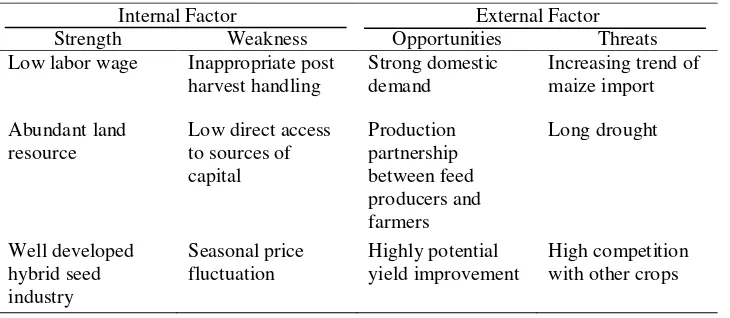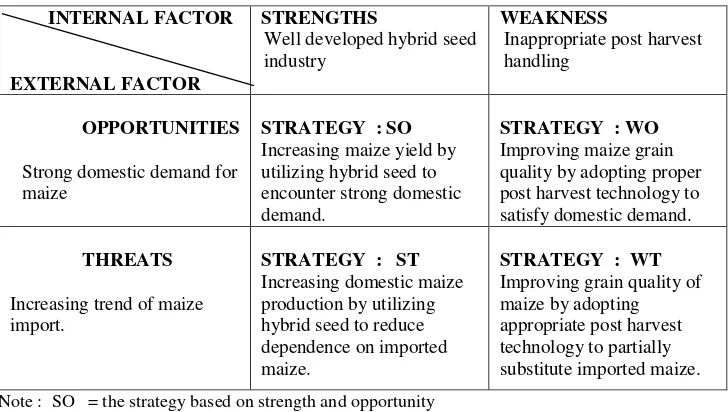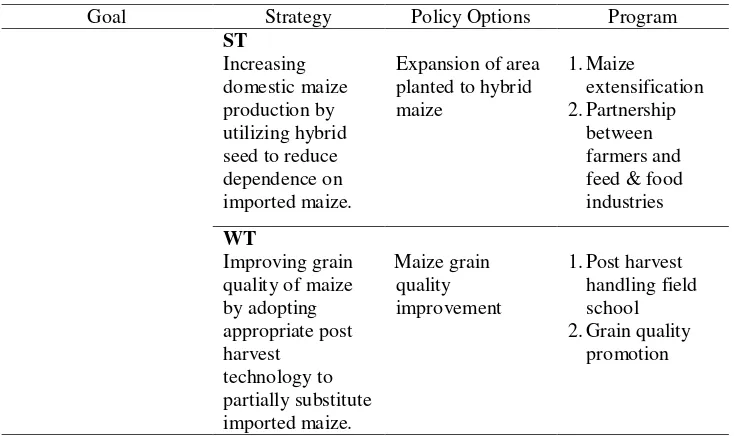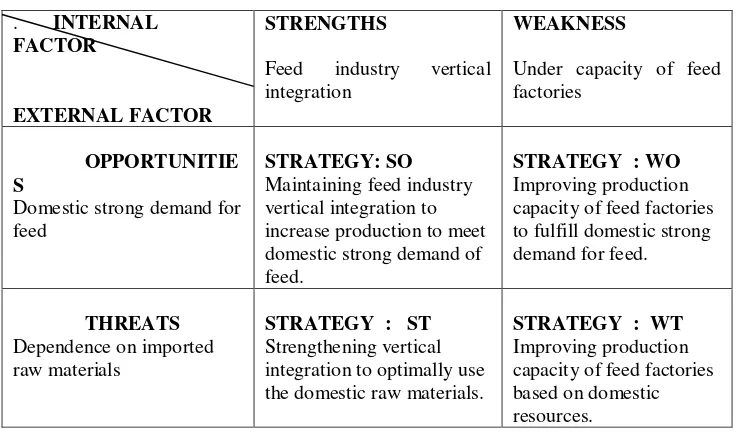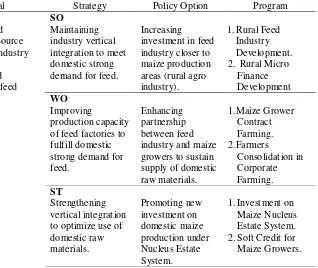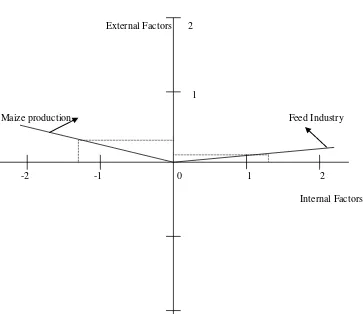THE STRATEGIC POLICY OPTIONS TO DEVELOP
MAIZE AND FEED INDUSTRY IN INDONESIA
Dewa K.S. Swastika, Made O.A. Manikmas, and Bambang Sayaka
Indonesian Center For Agricultural Socio Economic Research and Development Jl. A. Yani 70 Bogor
INTRODUCTION
Background
Maize is the most popular ingredient of manufactured feed in the world, especially in the tropic region. In Indonesia, maize is a major component of feed, accounting for about 51 percent of feed ingredient. Efforts to substitute some other crops for maize in Indonesia is likely unsuccessful (Tangedjaja, 2003). Thus the main feed crop for manufactured feed in Indonesia is maize.
Maize is also the second important food crop after rice. It was indicated by the percentage of area planted to maize, relative to total area planted for food crops. Kasryno (2002), reported that area planted to maize was about 19 percent of the total area planted to food crops during 1970-2000. Rice occupied about 61 percent of the total area planted to food crops. Another 20 percent were for other food crops (palawija) such as: soybeans, mungbeans, peanuts, cassava, and sweet potatoes.
For the last three decades, maize production has shown a substantial growth from 2.83 million tons in 1970 to 9.35 million tons in 2001 (FAO, 1971-2002). This increase was mainly attributed to the adoption of improved technology, especially high yielding varieties, including hybrids, resulting in a higher productivity. The rapid growth of production, however, failed to meet the domestic demand, causing a rapid increase in net import.
In the 1969-1975 period, Indonesia was self sufficient in maize, with the sufficiency indices of 1.02 to 1.26 (Swastika, 2002). The net import was increasing from 0.05 million tons in 1976 to 0.60 million tons in 1996 and reached its peak of 1.26 million tons in 2000. There should be a breakthrough to obtain self-sufficiency on maize for both food and feed. This study aims to identify the potential, opportunity, and constraints of maize and feed production system, and formulates strategic policy alternatives to develop maize and feed production.
Objectives and Expected Output
Indonesia, and (ii) to formulate strategic policy options to promote sustainable development of maize and feed production in Indonesia.
Expected output of the study consists of: (i) better understanding on potential, weaknesses, opportunities and constraints for expanding maize and feed production in Indonesia, and (ii) the strategies and policy recommendations to promote maize and feed production in Indonesia,
SWOT ANALYSIS
SWOT analysis is applied in order to have better understanding on potentials and constraints of maize production and feed industry in Indonesia. Following Sianipar and Entang (2001), the analysis comprised of various steps. Step 1, identification of internal and external factors. Step 2, determination of percentage of weighted internal and external factors (BF). Step 3, evaluation on supporting value of each internal and external factors (ND) by using score 1 to 5. Step 4, computation of supporting weighted value of those factors (NBD). Step 5, evaluation on level of linkage among internal factors and external factors using score 1 to 5. Step 6, computation of average value of factors linkage (NRK). Step 7, computation of linkage weighted value among internal and external factors (NBK) = BF * NRK. Step 8, computation of total weighted value (TNB) = NBD + NBK.
Based on the value of TNB, the most important strength, weakness, opportunity, and threat of each feed and feed crops expansion is respectively determined. Thus, strategy, policy option, programs and ultimate goal of feed industry as well as feed crops expansion in Indonesia is then formulated (Adnyana 2004).
RESULTS AND DISCUSSION
Analysis of Maize Production
maize production, those are: (1) increasing trend of maize import, (2) long drought possible to hamper maize production, and (3) high competition with other crops in term of planted area.
Table 1. Internal and External Factors of Maize Production in Indonesia, 2004
Internal Factor External Factor
Strength Weakness Opportunities Threats
Low labor wage Inappropriate post harvest handling
Strong domestic demand
Increasing trend of maize import
Abundant land resource
Low direct access to sources of capital
Production partnership between feed producers and farmers
Long drought
Well developed hybrid seed industry
Seasonal price fluctuation
Highly potential yield improvement
High competition with other crops
Based on the phases of SWOT analysis, the most essential internal and external factors are concluded as follows: (1) existing hybrid seed industry is highly developed (strength); (2) farmers usually do not conduct post harvest handling appropriately (weakness); (3) strong domestic demand for maize as the main raw materials for feed industry (opportunity); and (4) increasing maize import directly competing with domestic maize production. Following identification of four internal and external factors, the strategy of developing domestic maize production is formulated as: (1) increasing maize yield by utilizing hybrid seed to encounter strong domestic demand, (2) enhancing domestic maize production by utilizing hybrid seed to reduce dependence on imported maize, (3) improving maize grain quality by adopting proper post harvest technology to satisfy domestic demand, and (4) developing grain quality of maize by adopting appropriate post harvest technology to partially substitute imported maize (Table 2).
Table 2. Strategy Formulation of Maize Production in Indonesia, 2004
INTERNAL FACTOR
EXTERNAL FACTOR
STRENGTHS
Well developed hybrid seed industry
WEAKNESS
Inappropriate post harvest handling
OPPORTUNITIES
Strong domestic demand for maize
STRATEGY : SO Increasing maize yield by utilizing hybrid seed to encounter strong domestic demand.
STRATEGY : WO Improving maize grain quality by adopting proper post harvest technology to satisfy domestic demand.
THREATS
Increasing trend of maize import.
STRATEGY : ST Increasing domestic maize production by utilizing hybrid seed to reduce dependence on imported maize.
STRATEGY : WT Improving grain quality of maize by adopting appropriate post harvest technology to partially substitute imported maize.
Note : SO = the strategy based on strength and opportunity WO = the strategy based on weakness and opportunity ST = the strategy based on strength and threat WT = the strategy based on weakness and threat
The programs comprise: (1) maize intensification, (2) soft credit for maize production, (3) farmers training on post harvest handling, (4) provision of post harvest machineries through farm credit, (5) maize intensification, (6) partnership between farmers/farmers-group and feed mills or food industry, (7) post harvest handling field school, and (8) grain quality promotion (Table 3).
Table 3. Ultimate Goal, Strategy, Policy Options and Development Programs of Maize Production in Indonesia, 2004
Goal Strategy Policy Options Program Competitive domestic
maize production in terms of production cost and grain quality.
Table 3. (continue)
Goal Strategy Policy Options Program
ST
Analysis of Feed Industry
The internal (strengths and weaknesses) and external (opportunities and threats) factors of feed industry in Indonesia are identified, as presented in Table 4. This table exhibits that the strengths of feed industry are: (1) abundant labor and low wage, (2) strong vertical integration between feed and poultry industry, and (3) well develop feed production technology. Meanwhile, the weaknesses are identified such as: (1) low quality of feed, (2) feed market structure tend toward oligopolistic, and (3) present status that feed factories remain under capacity. On the other hand, opportunities to expand feed industry still widely open such as: (1) strong domestic demand, (2) there are opportunity for export promotion for standard quality feed, and (3) high potential to improve feed production quality. Nevertheless, serious threats are remain faced by feed industry in Indonesia such as: (1) highly dependence on imported raw material, (2) high interest rate of credit, and (3) immediate outbreak of poultry that significantly affecting feed industry.
strategy); (3) improving production capacity of feed factories to fulfill domestic strong demand for feed (WO strategy), and (4) improving production capacity of feed factories based on domestic resources (Table 5).
Table 4. Internal and External Factors of Feed Industry in Indonesia, 2004
Internal Factor External Factor
STRENGTHS WEAKNESSES OPPORTUNITIES THREATS
Abundant labor
Table 5. Strategy Formulation of Feed Industry Development in Indonesia, 2004
. INTERNAL FACTOR
EXTERNAL FACTOR
STRENGTHS
Feed industry vertical integration
Domestic strong demand for feed
STRATEGY: SO
Maintaining feed industry vertical integration to increase production to meet domestic strong demand of feed.
STRATEGY : WO
Improving production capacity of feed factories to fulfill domestic strong demand for feed. integration to optimally use the domestic raw materials.
STRATEGY : WT
Improving production capacity of feed factories based on domestic resources.
characteristics of competitive industry, means that feed industry in Indonesia should produce better quality of feed with less cost. In order to achieve above goals, four strategies are proposed that include four policy options and eight alternative programs. Policy options are: (1) increasing investment in feed industry closer to maize production areas (rural agro industry), (2) enhancing partnership between feed industry and maize growers to sustain supply of domestic raw materials, (3) promoting new investment on domestic maize production under nucleus-estate system, and (4) optimizing feed factories capacity through higher procurement of domestic maize production.
Meanwhile eight development programs include: (1) rural feed industry development, (2) rural micro finance for maize grower (3) contract farming, (4) farmers consolidation in corporate farming, (5) investment on maize nucleus estate system, (6) soft credit for maize growers (7) promotion on domestic maize use for feed industry and (8) maize post harvest handling improvement (Table 6).
Table 6. Ultimate Goal, Strategy, Policy Options and Development Programs of Feed Industry in Indonesia, 2004
Goal Strategy Policy Option Program
WT Improving
production capacity of feed factories based on domestic resources.
Optimizing feed factories capacity through higher procurement of domestic maize production.
1. Promotion on Domestic Maize Use for Feed Industry. 2. Maize Post
Harvest Handling Improvement.
Performance of Maize Production and Feed Industry in Indonesia
Mapping of domestic maize production and feed industry in Indonesia is carried out based on the net value of total weighted value (TNB) of each internal factors and external factors. For maize production, the value of TNB of internal factor is equal to –1.36 (Table 7), indicated that internally maize production in Indonesia is weak, such as characterized by farmers capital constraint, poor post harvest handling and low price of maize grain. In other words, maize production in Indonesia faced more weaknesses rather than strengths. However, in terms of external factors, the result is positive (0.36). It means that maize production in Indonesia has more opportunity than threat, indicating good opportunity to develop.
Mapping the results in Table 7 in the form of graph is as depicted in Figure 1, where horizontal axis represents internal factors, while vertical axis represents external factors. Figure 1 shows that maize production in Indonesia located at Quadrant II. This position indicates that maize production is in alert. Because, if there is an unfavorable change in external factors, it will fall into quadrant III and will be collapsed.
Table 7. Performance Mapping of Feed Industry and Domestic Maize Production
Industry Internal Factor External Factor
Feed Industry 1.34 0.01
Domestic maize production -1.36 0.36
become weak or almost bankrupt (Figure 1).
External Factors 2
1
Maize production Feed Industry
-2 -1 0 1 2
Internal Factors
Figure 1. Performance Map of Feed Industry and Maize Production in Indonesia
CONCLUSION AND POLICY RECOMMENDATION
Based on the above results and discussion, there are some conclusion can be drawn as follows:
production and followed by good quality of grain will improve maize farmers’ on-farm income.
2. To attain the goals, four strategic policy options are recommended. The policy options are: (1) promotion of hybrid seed application, (2) intensive application of appropriate maize post harvest technology, (3) expansion of area planted to hybrid maize, and (4) maize grain quality improvement. 3. The action programs that are necessary to implement comprised of eight
prioritized programs: (1) maize intensification, (2) soft credit for maize production (subsidized interest rate), (3) farmers training on post harvest handling and processing, (4) provision of post harvest machineries through farm credit, (5) maize extensification, (6) partnership between farmers and feed as well as food industries, (7) post harvest handling field school, and (8) promotion of grain quality management.
4. The outputs of SWOT analysis on domestic feed industry indicated that, the goals of domestic feed industry are: (1) resilient and domestic resource based feed industry, and (2) efficient and competitive feed industry.
5. In order to achieve above goals, four strategies are proposed, namely: (1) increasing investment in feed industry closer to maize production areas, (2) promotes partnership between feed and food industries and maize growers to sustain supply of domestic raw materials, (3) promoting new investment on domestic maize production under nucleus-estate system, and (4) optimizing feed factories capacity through higher procurement of domestic maize production.
6. To support those above strategies, eight development programs are recommended include: (1) rural feed industry development, (2) rural micro finance for maize grower (3) legal contract farming, (4) farmers consolidation in corporate farm management, (5) investment on maize nucleus estate system, (6) soft credit for maize growers (7) promotion on domestic maize use for feed industry and (8) maize post harvest handling improvement.
REFERENCES
Adnyana, M.O. 2004. Analisis Dampak dan Strategi Pengembangan Peningkatan Produktivitas Padi dan Ternak (P3T) ke Depan. Makalah disampaikan pada Seminar Puslitbangtan 29 Januari 2004.
Kasryno, F., 2002. Perkembangan Produksi dan Konsumsi Jagung Dunia dan Implikasinya Bagi Indonesia (The World Maize Production and Consumption, and Its Implication to Indonesia). Paper presented at One Day Seminar on Maize Agribusiness in Bogor, 24 June 2002. AARD. Bogor.
Swastika, D.K.S. 2002. Corn Self Sufficiency in Indonesia: The Past 30 Years and Future Prospect. Indonesian Agricultural Research and Development Journal. Vol. 21 No. 3. AARD. Jakarta.
